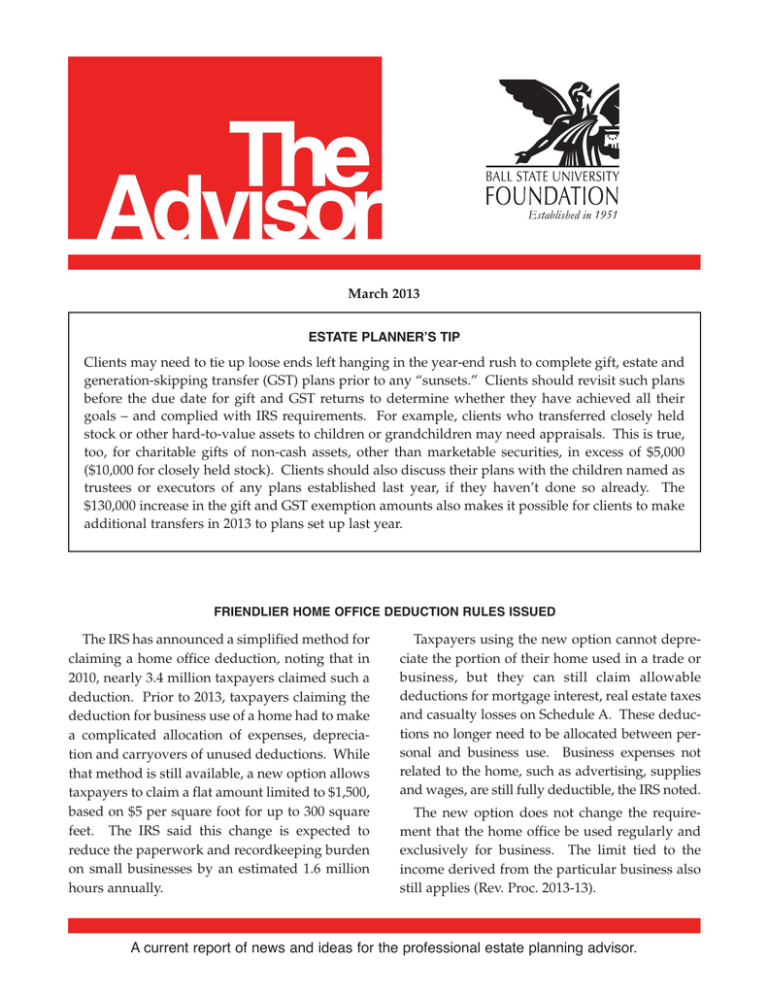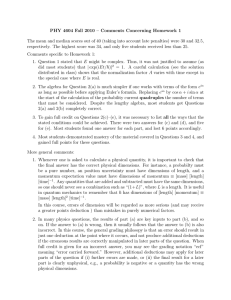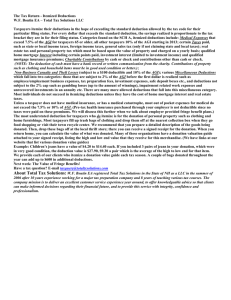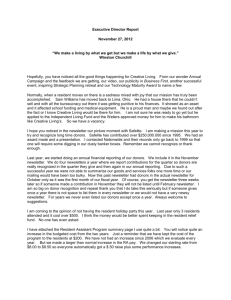The Advisor |
advertisement

The| Advisor March 2013 ESTATE PLANNER’S TIP Clients may need to tie up loose ends left hanging in the year-end rush to complete gift, estate and generation-skipping transfer (GST) plans prior to any “sunsets.” Clients should revisit such plans before the due date for gift and GST returns to determine whether they have achieved all their goals – and complied with IRS requirements. For example, clients who transferred closely held stock or other hard-to-value assets to children or grandchildren may need appraisals. This is true, too, for charitable gifts of non-cash assets, other than marketable securities, in excess of $5,000 ($10,000 for closely held stock). Clients should also discuss their plans with the children named as trustees or executors of any plans established last year, if they haven’t done so already. The $130,000 increase in the gift and GST exemption amounts also makes it possible for clients to make additional transfers in 2013 to plans set up last year. FRIENDLIER HOME OFFICE DEDUCTION RULES ISSUED The IRS has announced a simplified method for claiming a home office deduction, noting that in 2010, nearly 3.4 million taxpayers claimed such a deduction. Prior to 2013, taxpayers claiming the deduction for business use of a home had to make a complicated allocation of expenses, depreciation and carryovers of unused deductions. While that method is still available, a new option allows taxpayers to claim a flat amount limited to $1,500, based on $5 per square foot for up to 300 square feet. The IRS said this change is expected to reduce the paperwork and recordkeeping burden on small businesses by an estimated 1.6 million hours annually. Taxpayers using the new option cannot depreciate the portion of their home used in a trade or business, but they can still claim allowable deductions for mortgage interest, real estate taxes and casualty losses on Schedule A. These deductions no longer need to be allocated between personal and business use. Business expenses not related to the home, such as advertising, supplies and wages, are still fully deductible, the IRS noted. The new option does not change the requirement that the home office be used regularly and exclusively for business. The limit tied to the income derived from the particular business also still applies (Rev. Proc. 2013-13). A current report of news and ideas for the professional estate planning advisor. The Advisor Head of household Married filing separately 2012 2013 $122,300 $125,450 71,350 73,200 33% bracket starts Single Joint Head of household Married filing separately $178,650 217,450 198,050 108,725 $183,250 223,050 203,150 111,525 35% bracket starts Single, Joint, Head of household Married filing separately $388,350 194,175 $398,350 199,175 REMAINING INFLATION ADJUSTMENTS RELEASED Passage of the American Taxpayer Relief Act of 2012 put the final puzzle pieces in place, allowing the IRS to issue inflation adjustments for the tax brackets and the gift, estate and generation-skipping transfer tax exclusions for 2013 (Rev. Proc. 2013-15). 2012 Gift, generation-skipping transfer and estate tax exclusion 2013 $5,120,000 $5,250,000 IRA contribution limits $5,000 $5,500 Personal and dependent exemption $3,800 $3,900 Standard deduction Single Joint Head of household Married filing separately $5,950 11,900 8,700 5,950 $6,100 12,200 8,950 6,100 Tax brackets 25% bracket starts Single Joint Head of household Married filing separately $35,350 70,700 47,350 35,350 $36,250 72,500 48,600 36,250 28% bracket starts Single Joint $83,650 142,700 $87,850 146,400 PHILANTHROPY PUZZLER Marsha, a wealthy socialite, will soon receive a bequest from her father’s estate. Because she has no real need for additional income, she has asked the attorney for the estate whether she could disclaim the bequest and instead have it pass to a charity on whose board she serves, thereby giving her father’s estate a charitable deduction. Will the charity receive the bequest? Will the estate get a deduction? 39.6% bracket starts Single Joint Head of household Married filing separately $400,000 450,000 425,000 225,000 TRUST REFORM PRESERVES SCHOLARSHIPS Carol Vollmer provided in her living trust that, at her death, income from the trust was to be used to pay one or two $10,000 scholarships to students of the local high school annually, but if income is less than $10,000, the whole amount is to be paid out as a scholarship. Any income above an amount divisible by $10,000 that was not given out as a scholarship was to be added to principal. The trust applied for private foundation status, but the IRS said the instrument had to be amended to demonstrate a general intent to benefit charity, not merely a specific intent to benefit a particular institution. The trust contained no language showing general charitable intent under Code §501(c)(3), although providing scholarships is a charitable purpose. Without private foundation status, the trust could be subject to tax, reducing the income available to provide scholarships. The trustee proposed to reform the trust, due to a scrivener’s error, to show Vollmer’s general charitable intent. The trust was also to be changed to avoid tax on undistributed income, by providing that the scholarship committee could distribute all the funds in one or more The Advisor equal scholarships, each worth at least $10,000. The Supreme Judicial Court of Massachusetts noted that a trust can be reformed to conform to the settlor’s intent. The court found that the proposed reformations would not be adverse to any person’s interests and that it would further Vollmer’s intent that as much income as possible be used to provide scholarships (Rockland Trust Co. v. Attorney General, No. SJC-11257). NO RETURN, NO CARRYOVER Robert Naylor, who the Tax Court called “a habitual nonfiler,” claimed he was entitled to a carryover charitable deduction of nearly $90,000 in 2003. He said that a charitable gift made in 2002 by Midway Industrial Campus, Co., Ltd., a limited liability company, flowed through to the Naylor Family Partnership, of which he was a partner. The court noted that Naylor had the burden of proving that he was entitled to the deduction for 2002 and that the deduction could not be fully used in 2003, thereby entitling him to carry it over to 2003. Code §170(d)(1) limits deductions for cash gifts to 50% of the taxpayer’s “contribution base,” with any excess treated as a charitable contribution paid in each of the five succeeding taxable years. The IRS presented evidence that Naylor had not filed tax returns for 2002 through 2009. The IRS therefore prepared substitute returns for him [Code §6020(b)(1)]. The court determined that because Naylor failed to prove that he had filed a 2002 income tax return, he has no charitable contribution deduction to carry over to 2003 (Naylor v. Comm’r., T.C. Memo. 2013-19). COMPLIANCE LAX ON NONCASH GIFT SUBSTANTIATION The Treasury Inspector General for Tax Administration (TIGTA) estimates that 60% of taxpayers claiming large noncash charitable deductions are not complying with the reporting requirements, resulting in “approximately $3.8 billion in potentially erroneous noncash charita- ble contributions in 2010.” TIGTA made several recommendations to improve reporting, although the IRS did not agree that all of these will substantially improve compliance. Among the recommendations: n Expand the current process to identify all tax returns claiming noncash charitable contributions of more than $500 that do not have a Form 8283 attached. Deductions should not be allowed until the missing documentation has been provided. n Revise Form 8283 and instructions to require that taxpayers include the date of the contribution in addition to the donee acknowledgment for noncash gifts of more than $5,000. n Institute better controls to ensure donations of motor vehicles are properly reported. For 2010, 89,772 taxpayers claimed deductions for contributions of motor vehicles, with a total value of $242.5 million. Of these, TIGTA found that 42% did not have the supporting Copy A of Form 1098-C, or the value did not agree with IRS records. For vehicle donations after 2004, deductions are generally limited to the gross proceeds received by the charity upon a sale [Code §170(f)(12)(A)(i)]. Charity must provide an acknowledgment that identifies the vehicle and the donor, certifies that the vehicle was sold in an arm’s-length transaction and must disclose the gross proceeds of the sale. PUZZLER SOLUTION Marsha can’t direct how the bequest will be applied if she disclaims [Code §2518(b)]. The funds will revert to the residue of the estate and pass according to her father’s will. Even if Marsha were to accept the bequest and then make a gift to charity, the estate would not receive a charitable deduction because the bequest was not “transferred by the decedent” [Reg. §20.20551(a)] – although Marsha would receive an income tax deduction. The Advisor “BACK DOOR” TAX INCREASE RETURNS FOR MANY The American Taxpayer Relief Act of 2012 has brought back limitations to itemized deductions and personal exemptions for higher-income taxpayers [Code §§68,151(d)]. Phaseouts begin when adjusted gross income exceeds $250,000 for single taxpayers, $275,000 for heads of households and $300,000 for couples. These cutbacks first appeared in the Revenue Reconciliation Act of 1990, but had been eliminated by 2010. Under the new incarnation, certain itemized deductions are reduced by 3% of the amount by which a taxpayer’s adjusted gross income exceeds the threshold amounts, up to a maximum reduction of 80%. The cutbacks apply to the deductions for home mortgage interest, real estate taxes, state and local taxes, miscellaneous itemized deductions and charitable contributions. Phaseout levels are adjusted annually for inflation. How does the reduction work? Take the case of Roger and Linda who have combined AGI of $375,000. They lose $2,250 of itemized deductions ($375,000 - $300,000 = $75,000 x 3%). Does that mean they will lose some tax benefit when they contribute to their favorite charity in 2013? Most likely, the $2,250 cutback occurs whether they give anything to charity or not. Although technically the charitable deduction is subject to the cutback, in most cases donors will have sufficient “fixed” expenses to more than absorb the reduction. At their income level, Roger and Linda will most likely have deductions for mortgage interest, real estate taxes and state and local taxes – nondiscretionary items – that far exceed the $2,250 in cutbacks. Charitable gifts, on the other hand, are purely discretionary. It’s reasonable to advise clients that charitable deductions won’t be diminished if David W. Bahlmann, J.D. President/CEO the cutbacks are already covered by deductions for mortgage interest, real estate taxes and state and local taxes. According to the latest Statistics of Income Bulletin, in 2010 (the most recent year for which figures are available), taxpayers with AGI of $200,000 to $250,000 claimed average deductions for state and local income taxes of more than $11,400. Those same taxpayers claimed mortgage interest deductions of more than $16,350, on average. Either amount would be more than sufficient to absorb any deduction reductions at that income level. There might be a few taxpayers – those with extremely high income and very low fixed deductions – who would lose some of the tax benefits of charitable gifts. Here’s a simple formula to determine if a client’s gifts to charity will be affected by the cutbacks: 1. Estimate all deductions for state and local taxes, mortgage interest and miscellaneous deductions over 2% of AGI $_____ 2. Divide line 1 by 3% $_____ 3. Add $250,000/$275,000/$300,000 (depending on filing status) to line 2 $_____ The amount on line 3 is the AGI a donor can have before the deduction reduction affects charitable contributions. For example, a single donor with relatively few deductions for mortgage interest and taxes ($15,000) would need AGI of more than $750,000 before charitable deductions would be subject to cutbacks. It’s highly unlikely that a client with income that high could have itemized deductions of only $15,000. In most cases, it’s safe to advise clients that no deductions for gifts to charity will be “lost.” BALL STATE UNIVERSITY FOUNDATION P.O. Box 672, Muncie, IN 47308 (765) 285-8312 • (765) 285-7060 FAX Toll Free (888) 235-0058 www.bsu.edu/bsufoundation Philip M. Purcell, J.D. Vice President for Planned Giving and Endowment Stewardship If you know another professional advisor who would benefit from this publication, please contact The Foundation.





